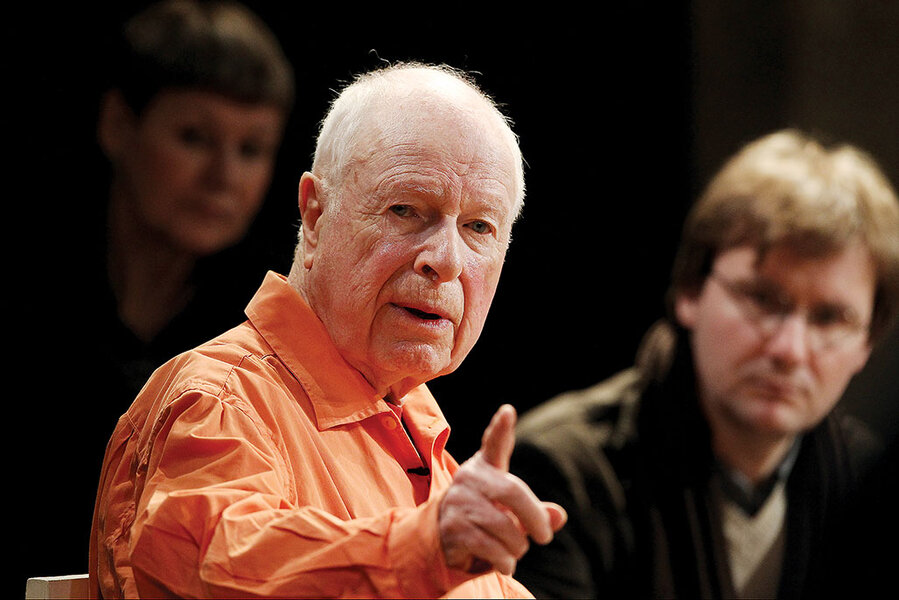'The Tightrope' shows a master of stagecraft uncloaked
Peter Brook is one of the most revolutionary theater directors of the past half century and yet his techniques, unlike those of so many other legendary theatrical figures, have always been somewhat shrouded in secrecy. In particular, his special performance exercise, “the tightrope,” has been a source of mystification to outsiders.
Now Brook’s son, Simon, a celebrated film director who previously made the documentary feature “Brook by Brook,” has, with his father’s blessing, cleared away some of the mystery in the French-Italian coproduction “Peter Brook: The Tightrope.” Except, of course, the real mystery remains: How do actors work their magic?
The tightrope exercise is superficially simple to describe. As Peter Brook looks intently on, his actors, grouped together in a small studio, take turns pretending to walk across the carpeted floor as if balancing on a tightrope. Swaying back and forth, lunging, occasionally falling, they do their best to mimic a vertiginous experience. To my untutored eye, they all looked quite convincing. For Brook, even the tiniest inflection of falsehood in the movements registers seismically. He’s like a human lie detector of performance art.
Brook believes in the intrinsic honesty of the theatrical event. “Be aware of what you are experiencing,” he tells his multiethnic students, some of whom are also dancers and musicians. He asks the tightrope walkers to develop an inward sensitivity, “as if your legs had eyes.” He makes the point that every part of the body should be as expressive as the face. “If the body isn’t alive, the soles of the feet forget.” This kind of hyperalertness is more than a performing trick; it is, for Brook, essential to all great acting. Imagination is fueled by authenticity.
This is why Brook, from the start, in the 1950s, championed less-is-more stagecraft. The British newspaper The Guardian once wrote of him: “It is only a slight exaggeration to say that, before Peter Brook came along ..., a Shakespeare play in the British theatre meant men in tights declaiming under a proscenium arch amid naturalistic stage sets.” As Brook says in the film, “there is no need for sets if the truth is there.”
Plenty of theatrical impresarios come on like gurus, and their ministrations can seem uncomfortably close to cultish. Brook, by contrast, never imposes his methodology; it simply arises from the work itself. He allows his acting students the luxury of failing, and he understands, as they do, that failure is part of the process. Brook casually says at one point, “I am not an actor,” but, of course, he is. He just acts offstage.
Simon Brook shot the film, which compresses several weeks’ worth of work, with five hidden cameras. The effect is of eavesdropping on a secret ceremony. The film is a model of cinematic transformation: We never feel that we are watching that dread dodo, “filmed theater.” Simon doesn’t give his father all the good close-ups, either. Each actor’s face is illumined by his or her avidity to get it right, not just to please the director but to enrich themselves. Peter Brook says that what distinguishes the actor from the nonactor is “a certain link between the pure imagination and the body itself.” He always wants his actors to go further into the theatrical experience in order to find “that extra opening when life enters into it.”
For anybody who ever saw (as I did), Brook’s legendary stage productions of “A Midsummer Night’s Dream” or “Mahabharata” (which was also made into a movie), the experience was transformative. To hear him talk about theater here, and unloose some of his secrets, is transformative, too.
“The Tightrope” may have started out as a nuts-and-bolts documentation of a theatrical workshop, but inevitably it becomes something much more than that – an expression of the elation we feel when we experience theatrical magic.
With Peter Brook acting as magician, it could not have been otherwise. Grade: A- (Unrated.)








